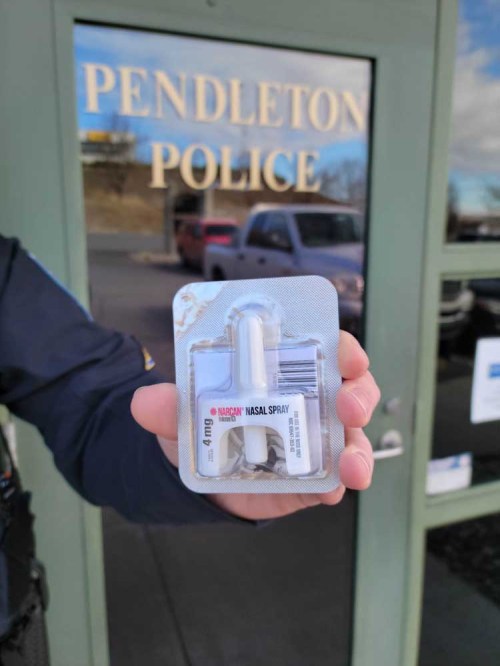Local authorities praise FDA approval of Narcan for over-the-counter sales
Published 9:00 am Wednesday, April 5, 2023

- A closer look at the Narcan nasal injector, which the U.S. Food and Drug Administration on March 29 approved for over-the-counter sales.
PENDLETON — Local first responders and addiction recovery services providers say the U.S. Food and Drug Administration’s move to allow over-the-counter sales of Narcan will save lives.
The U.S. Food and Drug Administration on March 29 approved Narcan, 4 milligram naloxone hydrochloride nasal spray for over-the-counter, nonprescription, use. The FDA in an announcement stated this was the first naloxone product it approved for use without a prescription.
“Narcan has an immediate life-saving effect and the potential side effects are less than most over-the-counter medications,” Community Counseling Solutions Director Kimberly Lindsay said. “CCS wholly supports the FDA’s decision to make intranasal Narcan available over-the-counter. It’s a benefit to our society.”
The FDA first approved intranasal naloxone spray in 2015 as a prescription drug and as a tool for first responders to help them immediately treat opiate overdose patients. The application to approve intranasal naloxone, or Narcan nasal spray for over the counter use was received and voted on by an FDA advisory committee, which unanimously approved the move.
Since its arrival in 2015, naloxone has become a mainstay of every paramedic and police officer in Oregon. The U.S. Centers for Disease Control and Prevention has hailed the drug or its fast-acting qualities.
According to the CDC, naloxone quickly reverses an overdose by blocking the effects of opioids. It can restore normal breathing within two to three minutes in a person whose breath has slowed, or even stopped, as a result of opioid overdose.
“The most important thing after an opiate overdose is to get people breathing again,” Pendleton Fire Chief Jim Critchley said. “If we can get people breathing again, the chance of success goes way up.”
When someone is overdosing on an opiate, Critchley said, their respiration diminishes until they stop breathing altogether.
“Naloxone kicks the opiate off and replaces it, biochemically,” Critchley said. “It blocks the sensation of the opiate and gets people breathing again, but people can get sick after, or even upset because they think we robbed them of their high.”
Critchley said he didn’t believe the general availability of naloxone would have a slippery slope effect or provide a perception that abusing opiates was safer.
“We believe FDA approval is a good thing in the same way that we have insulin for diabetics, inhalers for people with asthma and epinephrine for people with allergies,” he said. “I don’t believe the ease of use is the driving force behind us, it’s the high addiction rate of opiates themselves.”
According to the CDC, one of the benefits of naloxone becoming available is its lack of negative side effects. The CDC recommends anyone found overdosing on any drug should be given a dose of naloxone, as it “won’t harm anyone.”
Narcan is not yet available over the counter, and the FDA wrote the timeline would depend on the manufacturer’s ability to transition production from prescription to over-the-counter status, a process that could still several take months.
The American Medical Association has several recommendations on how to use intranasal naloxone, or Narcan, as follows:
• Once an opiate overdose has been identified, remove the Narcan nasal spray from its packaging.
• Hold the device with your thumb on the bottom plunger and two fingers on the nozzle.
• Place and hold the nozzle in either nostril until your fingers touch the bottom of the patient’s nose.
• Press the plunger firmly to release the entire dose into the patients nose.
• If a patient remains unresponsive after a first dose, a second may be required in the patients other nostril.





